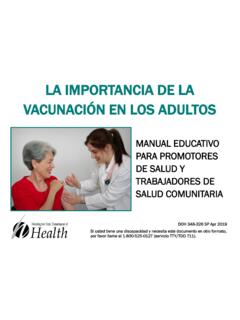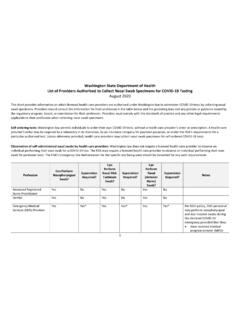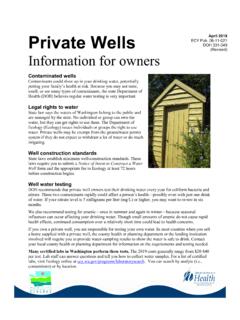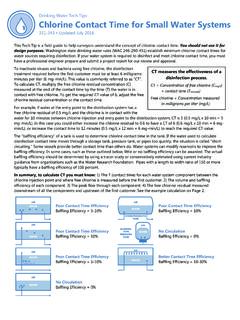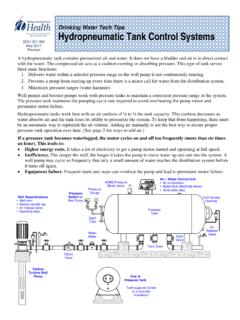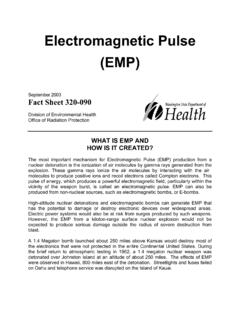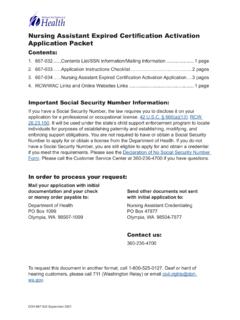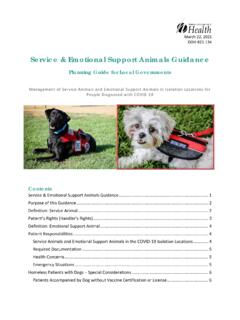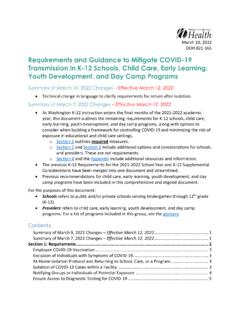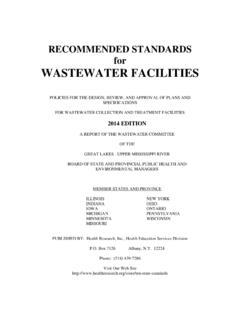Transcription of Recommended Standards and Guidance - Pressure …
1 Recommended Standards and Guidance for Performance, Application, Design, and Operation & Maintenance Pressure Distribution Systems February 2022 Recommended Standards and Guidance for Performance, Application, Design, and Operation & Maintenance Pressure Distribution Systems February 2022 For information or additional copies of this report contact: Wastewater Management Program Physical address: 101 Israel Road SE, Tumwater, WA 98501 Mailing Address: PO Box 47824, Olympia, Washington 98504-7824 Phone: (360) 236-3330 FAX: (360) 236-2257 Webpage: Email: Umair A. Shah, MD, MPH Secretary of Health To request this document in another format, call 1-800-525-0127. Deaf or hard of hearing customers, please call 711 (Washington Relay) or email Para solicitar este documento en otro formato, llame al 1-800-525-0127.
2 Clientes sordos o con problemas de audici n, favor de llamar al 711 (servicio de rel de Washington) o enviar un correo electr nico a DOH 337-009 February 2022 DOH 337-009 February 2022 Page 3 of 66 Contents Page Preface ..4 Introduction ..7 1. Performance Standards ..10 Intent ..10 Measure of Performance ..10 2. Application Standards ..12 Listing ..12 Permitting ..13 Pretreatment ..13 Pump Pumps, Fittings and Controls ..18 Piping Materials ..23 Manifold ..23 Laterals ..25 Minimum Design Submittal ..27 Construction Record Information ..28 User s Manual ..29 3. Operation and Maintenance ..29 Evaluate Drainfield ..29 Evaluate Laterals ..30 Measure Pump Run Time per Cycle and Drawdown ..30 Test Alarms.
3 30 Evaluate Septic Tank and Pump Findings and Figures ..32 Figure 1. Pressure Distribution Figure 2. Typical Septic Tank and Pump Chamber ..33 Figure 3A. Pressure Distribution Drainfield (Sloping Ground) ..33 Figure 3B. Pressure Distribution Drainfield (Sloping Ground, Manifold Below) ..35 Figure 4. Pressure Drainfield Cross Construction ..36 ..37 Figure 6A. Drainfield Control Box (Sloping Ground, Manifold Below Laterals) ..37 ..38 Figure 6B. Drainfield Control Box (Manifold Above Laterals) ..38 Figure 7. Orifice Caps and Shields ..39 Figure 8A. Cleanout and Monitoring Port ..39 Figure 8B. Monitoring/Cleanout Port (Example). Cap must be secured..40 Figure 9. Example of Siphon ..41 Pressure Distribution Systems Recommended Standards and Guidance Effective Date: February 1, 2022 DOH 337-009 February 2022 Page 4 of 66 Figure 10.
4 Siphon Tank High/Low Dose Volume Examples ..42 Appendix A Useful Tables for Pressure Distribution ..43 A-1: LATERAL DESIGN TABLES ..43 A-2: ORIFICE DISCHARGE RATE DESIGN AID ..49 A-3: FRICTION LOSS DESIGN AID ..51 A-4: MAXIMUM MANIFOLD LENGTHS ..54 Appendix B Volume of Pipe ..57 Appendix C - Advantages / Disadvantages of Dosing Systems ..58 Appendix D - Advantages / Disadvantages of Siphon Dosed Systems ..60 Appendix E - References ..66 Glossary of Terms: A glossary of common terms for all RS&Gs can be found on the DOH Web site at Preface The Recommended Standards contained in this document have been developed for statewide application. Regional differences may, however, result in application of this technology in a manner different than it is presented here.
5 In some localities, greater allowances than those described here may reasonably be granted. In other localities, allowances that are provided for in this document may be restricted. In either setting, the local health officer has full authority in the application of this technology, consistent with Chapter 246-272A WAC and local jurisdictional rules. If any provision of these Recommended Standards is inconsistent with local jurisdictional rules, regulations, ordinances, policies, procedures, or practices, the local Standards take precedence. Application of the Recommended Standards presented here is at the full discretion of the local health officer. Local jurisdictional application of these Recommended Standards may be: 1) Adopted as part of local rules, regulations or ordinances - When the Recommended Standards , either as they are written or modified to more accurately reflect local conditions, are adopted as part of the local rules, their application is governed by local rule authority.
6 2) Referred to as technical Guidance in the application of the technology - The Recommended Standards , either as they are written or modified to more accurately reflect local conditions, may be used locally as technical Guidance . Application of these Recommended Standards may occur in a manner that combines these two approaches. How these Recommended Standards are applied at the local jurisdictional level remains at the discretion of the local health officer and the local board of health. DOH 337-009 February 2022 Page 5 of 66 The Recommended Standards presented here are provided in typical rule language to assist those local jurisdictions where adoption in local rules is the preferred option. Other information and Guidance is presented in text boxes with a modified font style to easily distinguish it from the Recommended Standards .
7 The Recommended Standards contained in this document have been primarily written to support the design of on-site sewage systems with design flows less than 3500 gpd, but may also be applied to large on-site sewage systems (LOSS). With the adoption of the revised LOSS rule, chapter 246-272B WAC, in 2011, some provisions of the RS&Gs may not be appropriate or allowed for LOSS. Many applicable requirements from the RS&Gs have already been included in the LOSS rule. Design engineers and others interested in LOSS are directed to consult the rule and LOSS program staff before or instead of the RS&Gs. DOH 337-009 February 2022 Page 6 of 66 Typical RS&G Organization: Standards Section Explanation Performance How this technology is expected to perform (treatment level and function) Application How this technology is to be applied.
8 This section includes conditions that must be met prior to proceeding with design. Topics in this section describe the approved status of the technology, component listing requirements, permitting, installation, testing and inspection requirements, etc. Design How this technology is to be designed and constructed (includes minimum Standards that must be met to obtain a permit). Operation and Maintenance How this technology is to be operated and maintained (includes responsibilities of various parties, Recommended maintenance tasks and frequency, assurance measures, etc) Appendices Design examples, figures and tables, specific applications, and design and installation issues. DOH 337-009 February 2022 Page 7 of 66 Introduction Pressure distribution applies effluent uniformly over the entire absorption area such that each square foot of bottom area receives approximately the same amount per dose at a rate less than the saturated hydraulic conductivity of the soil.
9 This process promotes soil treatment performance by maintaining vertical unsaturated flow and also reduces the degree of clogging in finer textured soils. Pressure distribution closely approaches uniform distribution. (See Guidance section below) A Pressure distribution system consists of a pretreatment component to separate the major solid materials from the liquid, a screening device to protect the pump and distribution lateral orifices from solids, and a means to deliver specified doses of effluent, under Pressure , to the distribution system (Converse, 1974; Converse, et al., 1975; Otis, et al., 1978). The distribution system consists of small 1 to 2 inch diameter laterals with small discharge orifices. A Pressure head is created within the laterals, usually by means of a pump or siphon.
10 Pressure distribution is applicable to any system which uses soil as a treatment medium and may improve long term performance of those systems. It is required by WAC 246-272A for certain site and soil conditions, and for high daily design flows. Pressure distribution is also a required component for mounds, sand filters and sand lined trenches and beds. Research evidence indicates that wastewater traveling vertically through 2-4 feet of suitable, unsaturated soil provides adequate treatment of wastewater. Research also indicates that the method of distribution of septic tank effluent within the soil absorption field can affect the system's treatment performance. A frequently used, and the simplest method for distributing effluent is gravity flow.
